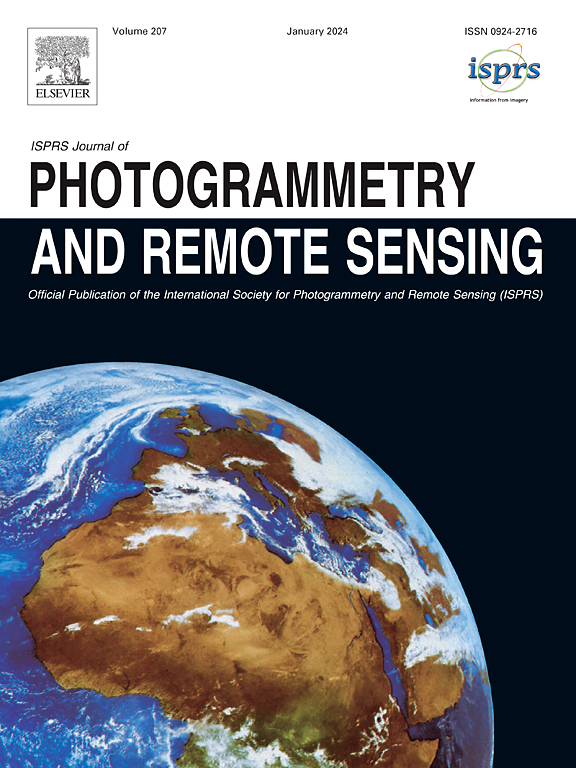Multimodal large language model for wheat breeding: A new exploration of smart breeding
IF 10.6
1区 地球科学
Q1 GEOGRAPHY, PHYSICAL
ISPRS Journal of Photogrammetry and Remote Sensing
Pub Date : 2025-05-15
DOI:10.1016/j.isprsjprs.2025.03.027
引用次数: 0
Abstract
Unmanned aerial vehicle remote sensing technology has become a key technology in crop breeding, which can achieve high-throughput and non-destructive collection of crop phenotyping data. However, the multidisciplinary nature of breeding has brought technical barriers and efficiency challenges to knowledge mining. Therefore, it is important to develop a smart breeding goal tool to mine cross-domain multimodal data. Based on different pre-trained open-source multimodal large language models (MLLMs) (e.g., Qwen-VL, InternVL, Deepseek-VL), this study used supervised fine-tuning (SFT), retrieval-augmented generation (RAG), and reinforcement learning from human feedback (RLHF) technologies to inject cross-domain knowledge into MLLMs, thereby constructing multiple multimodal large language models for wheat breeding (WBLMs). The above WBLMs were evaluated using the newly created evaluation benchmark in this study. The results showed that the WBLM constructed using SFT, RAG and RLHF technologies and InternVL2-8B has leading performance. Then, subsequent experiments were conducted using the WBLM. Ablation experiments indicated that the combination of SFT, RAG, and RLHF technologies can improve the overall generation performance, enhance the generated quality, balance the timeliness and adaptability of the generated answer, and reduce hallucinations and biases. The WBLM performed best in wheat yield prediction using cross-domain data (remote sensing, phenotyping, weather, and germplasm) simultaneously, with R2 and RMSE of 0.821 and 489.254 kg/ha, respectively. Furthermore, the WBLM can generate professional decision support answers for phenotyping estimation, environmental stress assessment, target germplasm screening, cultivation technique recommendation, and seed price query tasks. This study aims to improve the application of remote sensing in crop breeding by enabling precise assessment and prediction of wheat germplasm breeding materials in alignment with breeding goals, thereby accelerating the selection of superior varieties and better supporting the breeding decisions.
小麦育种多模态大语言模型:智能育种的新探索
无人机遥感技术可以实现作物表型数据的高通量、无损采集,已成为作物育种中的一项关键技术。然而,育种的多学科性质给知识挖掘带来了技术壁垒和效率挑战。因此,开发一种智能育种目标工具对跨域多模态数据的挖掘具有重要意义。本研究基于Qwen-VL、InternVL、Deepseek-VL等不同的预训练开源多模态大型语言模型(mllm),采用监督微调(SFT)、检索增强生成(RAG)和人类反馈强化学习(RLHF)技术向mllm注入跨领域知识,构建小麦育种多模态大型语言模型(wblm)。上述wblm采用本研究新建立的评价基准进行评价。结果表明,采用SFT、RAG和RLHF技术和internv2 - 8b构建的WBLM具有领先的性能。然后,使用WBLM进行后续实验。消融实验表明,SFT、RAG和RLHF技术的结合可以提高整体生成性能,提高生成质量,平衡生成答案的时效性和适应性,减少幻觉和偏差。WBLM在同时利用遥感、表型、天气和种质等跨域数据进行小麦产量预测时表现最好,R2和RMSE分别为0.821和489.254 kg/ha。此外,WBLM还可以为表型估计、环境压力评估、目标种质筛选、栽培技术推荐和种子价格查询等任务提供专业的决策支持答案。本研究旨在提高遥感在作物育种中的应用水平,根据育种目标对小麦种质育种材料进行准确的评估和预测,从而加快选育优良品种,更好地支持育种决策。
本文章由计算机程序翻译,如有差异,请以英文原文为准。
求助全文
约1分钟内获得全文
求助全文
来源期刊

ISPRS Journal of Photogrammetry and Remote Sensing
工程技术-成像科学与照相技术
CiteScore
21.00
自引率
6.30%
发文量
273
审稿时长
40 days
期刊介绍:
The ISPRS Journal of Photogrammetry and Remote Sensing (P&RS) serves as the official journal of the International Society for Photogrammetry and Remote Sensing (ISPRS). It acts as a platform for scientists and professionals worldwide who are involved in various disciplines that utilize photogrammetry, remote sensing, spatial information systems, computer vision, and related fields. The journal aims to facilitate communication and dissemination of advancements in these disciplines, while also acting as a comprehensive source of reference and archive.
P&RS endeavors to publish high-quality, peer-reviewed research papers that are preferably original and have not been published before. These papers can cover scientific/research, technological development, or application/practical aspects. Additionally, the journal welcomes papers that are based on presentations from ISPRS meetings, as long as they are considered significant contributions to the aforementioned fields.
In particular, P&RS encourages the submission of papers that are of broad scientific interest, showcase innovative applications (especially in emerging fields), have an interdisciplinary focus, discuss topics that have received limited attention in P&RS or related journals, or explore new directions in scientific or professional realms. It is preferred that theoretical papers include practical applications, while papers focusing on systems and applications should include a theoretical background.
 求助内容:
求助内容: 应助结果提醒方式:
应助结果提醒方式:


